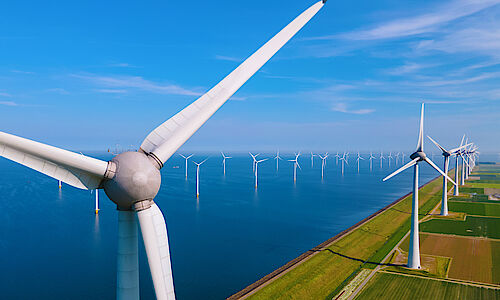News & Academies' activities
Workshop "Solar Energy (Concentrating Solar Power)" in Athens, Greece
Report of workshop "Solar Energy (Concentrating Solar Power)"
Held at the Academy of Athens, 9th December, 2011
The workshop was held at the Academy of Athens to consider developments in concentrating solar power (CSP) across Europe, and their potential implications for the application of solar power in Greece and Cyprus. It was held to mark the occasion of EASAC's 10th anniversary, and included a presentation on EASAC's report on CSP, recently published. The workshop programme can be found at the end of this report as well as the workshop presentations.
Introductory presentations described the energy policy context in Greece and Cyprus, and presented the findings of a study on the potential impacts of climate change in Greece. Short presentations on the energy programmes of the Academy of Athens and EASAC then preceded a summary of the EASAC CSP study. Presentations on CSP developments in Spain and Italy, and on the Desertec initiative followed and led into a panel discussion to conclude the workshop. Summaries of the presentations and of the panel discussion follow.
Renewable Energy Programs of Greece: Dr Panayiotis Chaviaropoulos
Dr Chaviaropoulos is Head of the Renewable Energy Sources Office at the Greek Ministry of Environment, Energy and Climate Change. He summarised Greece's National Action Plan for Renewable Energy Sources (RES) for the period 2010 to 2020. It aims to reform the country's energy sector so that 20% of primary energy is derived from RES by 2020 (40% in the electricity sector). For electricity, the major contributions are planned to come from wind, PV and hydro. More limited contributions are anticipated from other renewable technologies such as CSP, biomass and geothermal energy.
The total required investment for the plan is 22.2 billion euro, of which 16.5 billion euro will be for new RES capacity. To support the required RES developments, a new legislative framework was established in 2010 which aims to simplify and accelerate the licensing of RES projects, provide attractive feed-in tariffs, and address NIMBY issues.
71 CSP plants currently have an energy production license in Greece, totalling 379.7 MW capacity, but are not yet operational. Most are small plants (with capacities of 1-3 MW), but there are 5 larger plants with an energy production license on Crete with a total capacity of 243 MW.
Energy policy in Cyprus: Professor Constantinos Christofides
Professor Christofides of the University of Cyprus explained that a key, recent event for the energy system in Cyprus had been the explosion in July 2011 at the Evangelos Florakis naval base, which left 13 people dead and caused extensive damage to the Vasilikos power plant. As a result, over 50% of Cyprus' power capacity was rendered inoperable, so recent months have been about crisis management in electricity supply in Cyprus.
The major part of Cyprus' electricity supply is derived from gas and steam turbines. A transition to a low carbon energy mix is planned for the medium term (2020-2030), and to a hydrogen economy towards 2050. Already, some 80 MW of wind power is installed, but as solar irradiation in Cyprus is one of the highest in Europe, PV and CSP are anticipated to make a significant contribution in future. A 50 MW parabolic trough CSP plant has been proposed for the area of Acrotiri Limassol which would incorporate 7.5 hours of thermal storage.
The environmental, economic and social impacts of climate change in Greece: Professor Christos Zerefos
Professor Zerefos of the Academy of Athens summarised the findings of a study sponsored by the Bank of Greece of the potential impacts of climate change in Greece. He began by describing climatic variations in Greece over the previous century, and went on to consider future emissions scenarios and their potential implications. He focused on an end of 21st century outcome in which average air temperatures in Greece will increase by 3.0-4.5 °C, precipitation will decrease by 5-19%, and cloud cover will decrease by 8-14%. Outcomes will vary significantly across Greece.
Other important changes are expected to include more extreme precipitation events, longer drought periods and more days with elevated fire risk. The duration of the dry season is expected to increase by 40 days by the end of the century. There will be major negative impacts on the economy from lower water resources, sea level rise, impacts on fisheries and agriculture, and losses in biodiversity and forest productivity. Public health will also be negatively impacted.
The cost of a no-action scenario was estimated as equivalent to a 2% reduction in GDP by 2050, and 6% by 2100: corresponding to an accumulated cost of € 701 billion (i.e. 3x Greece's current GDP). A mitigation scenario comprising GHG emission reduction investments of 142 billion leads to an accumulated saving of 265 billion compared to the no-action scenario.
Activities of the Energy Committee of the Academy of Athens: Professor Loucas Christophorou
Professor Loucas Christophorou, Chair of the Academy of Athens' Energy Committee, explained that the Committee had been established by the Academy in 2005. Its purpose is to provide sound knowledge and information on energy issues, serve as a catalyst for enhancing efforts in the area of energy, and to offer independent advice to policy makers and politicians in Greece.
The Committee has organised symposia on energy conservation, energy and the environment, materials for energy applications and the search for hydrocarbons (pending), and has established working groups to conduct studies on nuclear power and energy needs in Greece and on electricity generation in Greece. Outputs of these initiatives have included broadly disseminated reports, press releases, and follow up lectures.
There are no operational CSP plants in Greece at present, but the solar conditions are suitable, particularly in Southern Greek Islands. It is therefore anticipated that CSP will play a significant role in Greece electricity supply in future.
EASAC's energy programme: Dr John Holmes
Dr Holmes, EASAC's Energy Programme Secretary, explained that the aim of EASAC's Energy Programme is to provide independent advice from the Academies on the scientific and energy issues impacting on European energy policy making. Distinguishing characteristics are the access to leading scientists provided by the academies, its rigorous independence, its ability to challenge current thinking, and its foundation in 10 years of EASAC's advice provision to EU policy makers. A Steering Panel advises EASAC Council on the development of the programme and helps to ensure that study outputs are of high quality and impact.
Studies on the European electricity grid and CSP have been completed, and studies on carbon capture and storage and sustainable bio-fuels are underway. New initiatives in 2012 include studies on village-level energy in developing countries, breakthroughs in low carbon energy, systems approaches in energy, and a workshop on the nuclear fuel cycle.
The EASAC CSP study: Professor Robert Pitz-Paal
Professor Pitz-Paal, Chair of the EASAC CSP working group, explained that the EASAC CSP report that was compiled by distinguished scientists with a broad range of competences, nominated by the national academies of science of several European countries, and by the academies of Egypt and Israel.
A key finding of the study is that CSP has the potential to become competitive with electricity generation from fossil fuel based power production between 2020 and 2030 in sun-rich countries. Due to the integration of thermal storage and fossil hybridisation CSP can inherently provide a similar service to the electric system as conventional power plants including dispatchable energy supply, a high capacity value and other grid services. Therefore, CSP can also enable high shares of other fluctuating renewable energy technologies (like wind or PV) on the grid.
It was also found that the environmental impacts of CSP plants are generally low. CSP technologies are consistent with a high share of local value creation which, with appropriate investments in skills and manufacturing facilities, may be expected to increase over time. This local benefit is more pronounced than for other renewable technologies such as PV, and supports economic development, particularly in countries with increasing industrialisation, creating local jobs, wealth and expertise. This makes the technology particularly suitable for the MENA (Middle East and North Africa) region. Based on these findings, the report makes a number of recommendations to EU policy makers.
The Spanish experience of CSP: Professor Cayetano Lopez
Professor Cayetano Lopez, Director General of CIEMAT in Spain, summarised the energy situation in Spain. A key challenge is to reduce the carbon content of Spain's primary energy supply. Energy saving and efficiency increases, more renewables, retention of nuclear capacity and possibly clean coal technologies will all need to play a role. None of the alternatives is free of problems, and a big effort in technology development will be needed along with strong political support.
In 2010, renewables accounted for 35% of Spain's electricity supply. In recent years, Spain has led the world in the development and deployment of CSP. In October 2011, 22 CSP plants comprising 902 MW capacity were in operation. 2500 MW are planned to be operational by the end of 2013. CSP capacity is anticipated to rise to 3000 MW in 2015 and 4800 MW in 2020.
The CSP plants incorporate thermal storage which provides for a good match of output to daily demand curves. Technical developments continue, not least on the use of direct steam generation, and the Solar Platform in Almeria provides an important experimental test facility. Another interesting development is the application of CSP to detoxifying polluted water.
CSP developments in Italy: Dr Fabrizio Fabrizi
Dr Fabrizio Fabrizi described ENEA's objectives for CSP development and its technological innovations, and discussed emerging concepts for CSP. ENEA has 70 people working on the development of CSP taking R&D from the laboratory to industrial demonstration of new technologies. ENEA works on a wide range of CSP technologies: a key development has been the development of molten salt as both process fluid and thermal storage medium. A demonstration plant has been established in Sicily which integrates a 5MW CSP plant with a gas-fired combined cycle power plant.
The strategic vision for CSP in Italy is for 30-50 MW plants fed by solar and biomass, which are suited to the capabilities and requirements of the local territory. ENEA are also working on a range of novel thermal energy storage concepts intended to reduce the capital cost of storage systems. Hydrogen production from CSP is a longer term development goal. ENEA are also working on the MATS CSP project in Egypt with local partners.
The Desertec Initiative: Dr Oliver Steinmetz
Dr Oliver Steinmetz is a co-founder and member of the supervisory board of the Desertec Foundation. He explained the concept behind Desertec, in particular the vast solar resource which exists in close proximity to key electricity demand centres. In the Desertec concept CSP is integrated with other renewables and HVDC. An important motivation is the proposition that the wealth, well-being and peace of partner countries in and near desert regions depends on access to energy, water and food.
The role of the Desertec Foundation is to promote the vision, act as a networking and coordination hub, and as a roadblock remover. The associated Desertec Industrial initiative now involves 55 organisations.
Panel Discussion: Professor Robert Pitz-Paal, Professor Cayetano Lopez, Dr Fabrizio Fabrizi, Dr Oliver Steinmetz
Responding to a question on anticipated costs of CSP in relation to other power generating technologies, Professor Pitz-Paal explained that the EASAC study came to a confident conclusion that CSP costs should halve over a period of around 15 years, provided that CSP capacity continues to be installed at an increasing rate. This should make it cost competitive with fossil-fired technologies, particularly when CO2 costs are fully integrated. However, more transparency is needed in cost data in order to increase confidence in projections. Professor Lopez drew an analogy with wind power costs in Spain which had reduced from 35-40p/kWh in 1980 to 5-7p/kWh now.
Professor Lopez indicated that there is currently a conflict between long-term needs to develop CSP and short-term market conditions. The continued deployment of technologies such as CSP, which are currently more expensive than alternatives (but which will be cost competitive and a necessary component of future renewables-based electricity systems), requires political will and long-term vision. There is at present a debate in Spain about whether, in the short-term, the country can continue to subsidise technologies such as CSP.
Dr Fabrizi pointed to reductions in costs of CSP mirrors that had already been achieved: from 300 €/m2 to 40 €/m2. Further cost reduction to 3 €/m2 may be anticipated through the replacement of glass in mirrors. From a technical point of view, there is a lot of scope to reduce CSP costs.
Displacement of imported oil and gas is an important motivator to develop CSP, and Dr Steinmetz indicated that this may be why Morocco is taking a lead among the Southern Mediterranean countries in developing CSP: 10% of its GDP is spent on oil imports.
In response to a question about the current cost advantage of PV in relation to CSP, Professor Pitz-Paal agreed that market conditions had recently caused problems for some CSP projects. However, more positively, China, India and South Africa had recently committed to CSP projects, partly due to some aggressive pricing of CSP plants. Political will is needed to look ahead, and to find a way for both PV and CSP to continue to progress.
Responding to a claim that CSP plants in Spain only have storage because there is a 50 MW cap on plant capacity to receive the feed-in tariff, Professor Lopez explained that it is not the cap which is the reason. Rather, it is the fact that addition of storage results in incremental kWh/s at lower cost. For example, in the US a 140 MW plant has just been built in a situation where there is no cap to capacity for the feed-in tariff, and this plant has included 6 hours storage.
A question was raised about why there is no activity to develop small-scale CSP units to generate power, perhaps for installation on rooftops. Professor Lopez explained that the power generation components tend to be prohibitively expensive for small units, but small-scale units for industrial heat generation are under development.
Discussion of building new overhead lines to support the deployment of renewable energy sources pointed to the delays to securing permits to construct. Underground cables can be used in some circumstances, but are expensive and unsuitable for some terrains. One option is to retrofit existing lines with high voltage direct current lines which may ease permitting problems.
CSP workshop presentations
- 1 Dr. Panagiotis CHAVIAROPOULOS Academy of Athens
- 2 Professor Constantinos CHRISTOFIDES- Energy Cyprus Policy, Athens
- 3 Professor Christos ZEREFOS Parousiasi
- 4 Professor Loucas CHRISTOPHOROU AA-EASAC meeting, Dec. 2011
- 5 Dr John Holmes EASAC Energy Programme
- 6 Professor Robert PITZ-PAAL - Concentrating Solar Power
- 7 Professor Cayetano LOPEZ CSP in Spain_Athens_December-2011
- 8 Dr Fabrizio FABRIZI - Solar Energy
- 9 Dr Oliver Steinmetz - Desertec Initiative
































